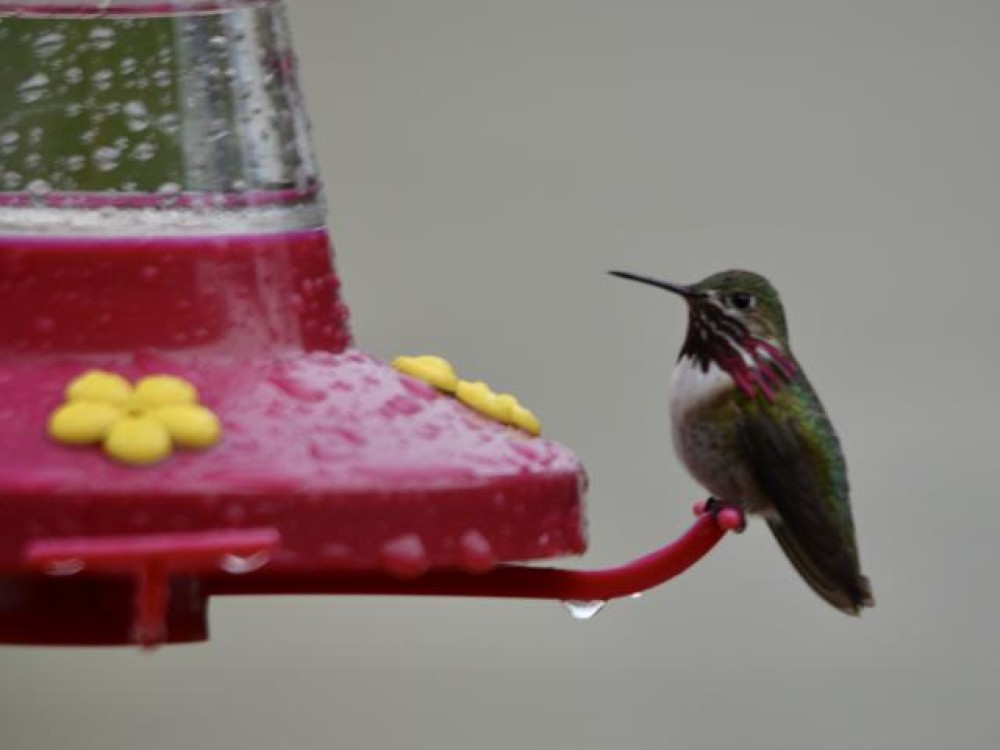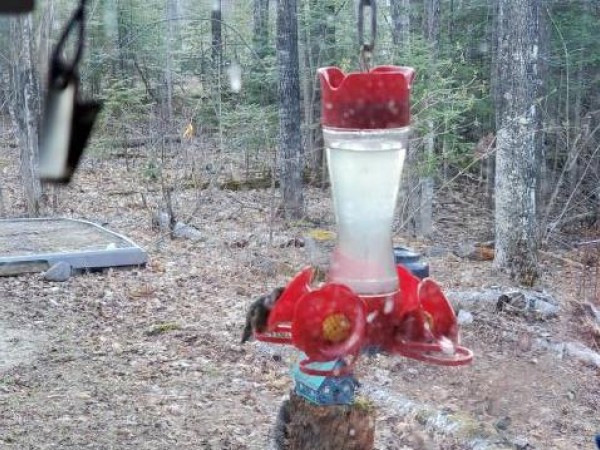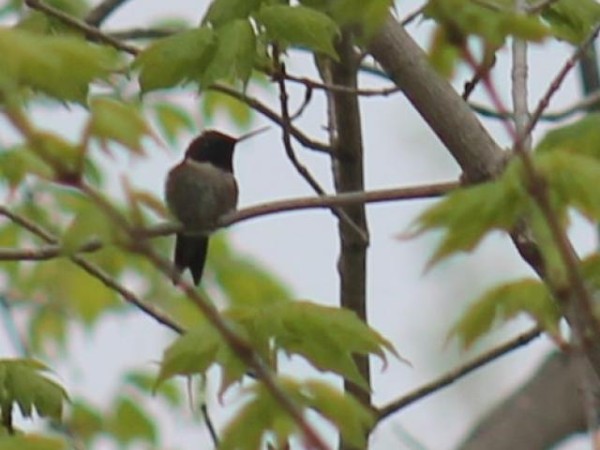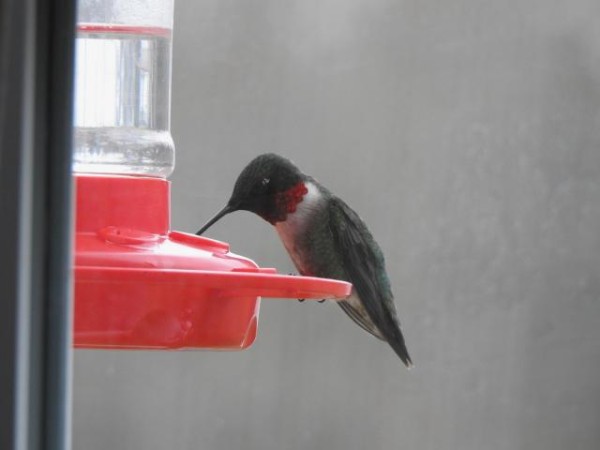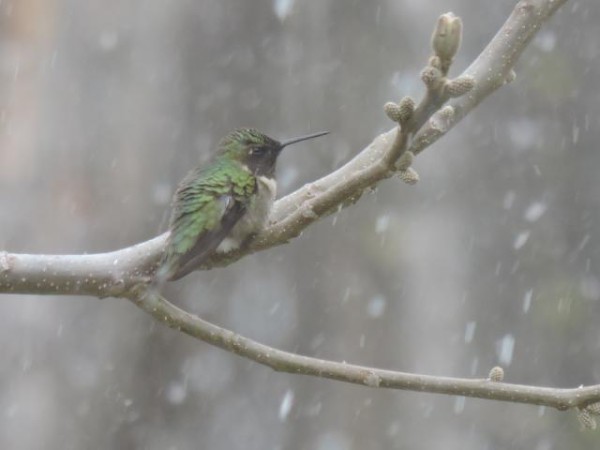More Hummingbird Arrivals
Ruby-throated Hummingbirds Reach Farther North
Another fantastic week for Ruby-throated hummingbirds. Aided by winds first sightings were reported all the way north from Minnesota, Michigan and Maine to Ontario, Quebec and New Brunswick.
Baltimore Orioles have been observed arriving at the same time as Ruby-throated Hummingbirds. Compare the two migration maps for Baltimore Orioles and Ruby-throated Hummingbirds. What patterns do you see? Go To: Baltimore Oriole map
Female Ruby-throated Hummingbirds are also being sighted.
Are we reaching peak migration yet? Keep reporting.
From Duluth, MN: Alan reported, "1st sighting of the year. We had a warm front move in yesterday with 50 mph gusts and the must have flown in on that wave. So happy to see them as it was a long winter as my last bit of snow just vanished yesterday. (05/03/2020)
From Fairfax, MN: Bix noted, "Each year for several years we have seen hummingbirds getting nectar from Ohio buckeye flowers in Fort Ridgely State Park. This first one was near a buckeye tree that is starting to bloom. My wife may have seen a second one too." (05/04/2020)
From Canton, MI: Nathan submitted the report, "What a great Star Wars Day! I got a new Boba Fett helmet in the morning (first one since I outgrew the fiberglass one my Dad made me 40 years ago), and then I was treated to my first hummer sighting in the evening...It was a Male Ruby-throated Hummingbird...He sat on one of my shepherd's hooks and then came to 3 out of the 4 little Vermillionaire Cigar Plants I'd purchased on Sunday. I'm thankful he's back! He's a welcome bit of joy and wonder and his flashing gorget is a beacon for brighter days to come! I hope everyone has a wonderful 2020 Hummbirding Season! p.s. Thank you Journey North for continuing to have an annual Hummingbird Migration Map! It's exceptionally brilliant to not only see the hummers' northward spread, but to be able to read the stories associated with all those little dots on the map and share in the excitement they bring to the folks reporting them! (05/04/2020)From Fairfax, MN: Bix reported, "Each year for several years we have seen hummingbirds getting nectar from Ohio buckeye flowers in Fort Ridgely State Park. This first one was near a buckeye tree that is starting to bloom. My wife may have seen a second one too. (05/04/2020)
From Hope, ME: Micki reported, "First sighting of the 2020 season! Yea!" (05/07/2020)
From Ottawa, ON: Judith exclaimed, "What a treat!...First hummingbird and first Oriole on the same day." (05/07/2020)
From Campobello Island, NB: Beatrix noted, "came several times back to test feeder." (05/03/2020)
From St-Lucien, QC: Perrine reported, "first female of the season." (05/08/2020)
Rufous Hummingbirds Continue Moving North and Into Interior
The Rufous begin their migration from the wintering grounds as early as January. Traveling along the Pacific Coast, they reach the northernmost point of the breeding range in Alaska by mid-May. Rufous Hummingbirds are well adapted to cold temperatures. This allows them to migrate into areas where night time temperatures in early spring may drop below freezing. They can survive sudden cold and snows typical in springtime. Many hummingbirds use torpor occasionally to survive cold nights, but Rufous Hummingbirds routinely go into torpor at night, probably because it may freeze at night even in July in their nesting grounds in Canada and Alaska. Keep reporting and submitting photos of Rufous Hummingbirds.
From Emmett, ID: Janice reported, "I just moved to Emmett Idaho and I put 2 feeders out approximately 3 weeks ago, and this morning much to my delight I spotted a Rufous going from feeder to feeder. (05/01/2020)
From Cardston County, AB: Nancy saw her "first female Rufous at feeder tonight..." (05/05/2020)
Broad-tailed and Black-chinned Hummingbirds
Broad-tailed and Black-chinned hummingbirds have been observed in Utah, Wyoming and Colorado and as far north as British Columbia. More sightings -- and photos are needed.
From Laramie, WY: Patricia, "Heard and then saw my first Broad-tailed male [Hummingbird] at my deck feeder. I am so excited!" (05/01/2020)
From Coldstream, BC: Gregg reported his first male Black-chinned (05/02/2020)
Behavioral Observations Needed Too!
Breeding Behavior: When establish breeding territories, male hummingbrids can become aggressive. Hummingbirds will begin building nests soon too. If you seen these behaviors, please submit your observations to Hummingbird, Other Observations
Nectaring Behavior: While hummingbirds frequently your backyard feeders, they also rely on nectar rich flowers. If you observe hummingbirds nectaring from plants, please report these observations to Hummingbird, Nectaring from Flowers. If you know plant names, submit this information in the comment section also.
